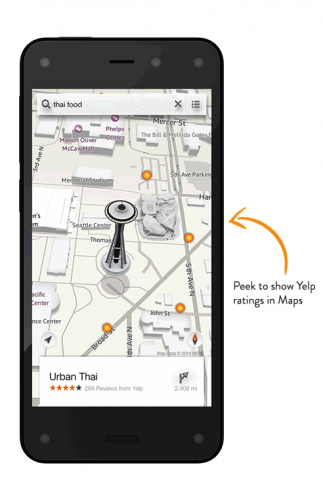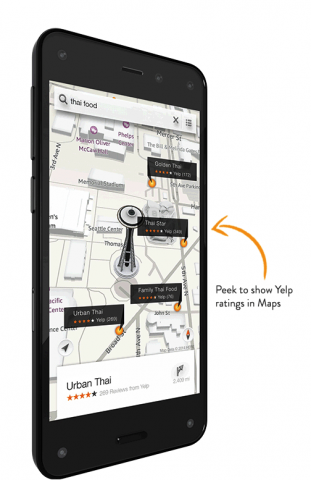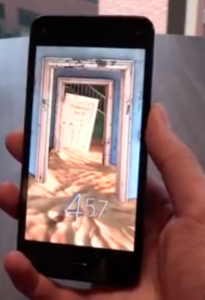Back on April 13 we picked up a rumor that Sharp was going to make a UHD/4k display in a 5.5″ diagonal package for mobile devices that includes 3860 x 2860 pixel resolution and a whopping 806 pixels per inch.

Fire phone’s Dynamic Perspective on its fullHD display reveals more content with advanced tilt and eye-tracking sensors
To some, the idea of such a high res panel in such a small package seems as far off as a “belated April Fools joke”, but as Meko display analyst Norbert Hildebrand suggests, the trends are moving this way. Just one day after our Meko rumor story on Sharp, IDG news service confirmed the display, reporting that Sharp showed the device at the Shenzhen, China Information Technology Expo and backed it up with a Sharp contact, spokeswoman Miyuki Nakayama. Sharp is using its IGZO backplane technology to deliver on the ground breaking pixel density and while its function may be hard to imagine beyond engineering overkill, let’s consider the potential for such a display.
At first glance, the idea of a full UltraHD image on a smartphone held in close proximity to the users’ eyes does indeed seem like overkill. As pointed out in the Hildebrand “Rumor” article, visual acuity of 20/20 would require a distance of just 5″ to see pixels on a 5.5″ diagonal UHD/4k panel display. But to others, such arguments miss the point entirely. The killer application that justifies higher pixel density displays has absolutely nothing to do with improving the quality of a single image and everything to do with packing more information into a fixed display space. A kind of de-coupling of the display size with the amount of information that can be displayed, and those extra pixels are just the ticket.
The idea of desktop real-estate benefiting from high density pixel displays is not new. Broadcom showed off such a system at CES 2014 in its “walled garden” exhibit that required a special invite to get in. Once in, the company demonstrated its version of the future of high definition content delivery and display that put UltraHD/4k at the center of the living room experience. A nested 50″ full HD image of NFL Sunday playing on a 70″ diagonal set, surrounded by smaller windows of live video feed streaming real-time from home cameras (baby room monitor etc.), and social networks (friends let’s say) watching and commenting on the very same game remotely. It is desktop real estate very much like how one uses a display monitor, only in the living room on the big screen.
The best mobile example of this concept comes in the form of “Dynamic Perspective” launched as a feature in the (so far) ill-fated Amazon Fire Phone. Packed with innovations that include four low power cameras and IR-LEDs (serving as advanced sensors), a custom graphic engine to handle real-time computer vision algorithms with rendering at 60Hz. Among other things, the advanced sensor-display system responds by revealing enhanced display content with a simple tilt or off-axis viewing of the screen (see image). In one example Amazon shows how Yelp ratings are revealed in a mapping app simply by tilting the device a bit off-axis. One can see how a high pixel density display can be used to enter further into an “internal 3D” space, using this technology. Amazon has dropped pricing yet again on its flagship smartphone, now selling unbundled at $189 and is delivered with a free year subscription to Amazon Prime (a $90 value-and well worth it!).

 In all, we see the Sharp move toward an UltraHD/4k mobile display as going in the right direction, not because we need that many pixels to create a better image but because it’s an innovative way to display more relevant content without growing the screen size. As any believer in unintended consequences will tell you, it’s only a matter of time before a real “killer app” for this Dynamic Perspective display technology will emerge. Perhaps then it will be Apple and Samsung playing catch-up with some in the industry asking “what just happened…?” We’ll see. – Steve Sechrist
In all, we see the Sharp move toward an UltraHD/4k mobile display as going in the right direction, not because we need that many pixels to create a better image but because it’s an innovative way to display more relevant content without growing the screen size. As any believer in unintended consequences will tell you, it’s only a matter of time before a real “killer app” for this Dynamic Perspective display technology will emerge. Perhaps then it will be Apple and Samsung playing catch-up with some in the industry asking “what just happened…?” We’ll see. – Steve Sechrist
Editor’s Comment
This topic is a continued source of interest. Back last year, Candice Brown Elliot wrote a The Display Resolution War – How much resolution is enough? on the topic of resolution that is worth a look if you didn’t see it. She followed that up with a second article (The Display Resolution War – How much resolution is enough? (Part 2).
Ken Werner wrote How Many Pixels are Enough? on the topic of resolution, based on issues of resolution in video applications.
My view is that human vision is complex. 20/20 vision can be represented as a resolution of around 30 cycles per degree (a metric that makes the resolution independent of viewing distance). 20/10 vision is 60 cpd, but NHK scientists looking at Super Hi-Vision have shown that some viewers can see an “increase in realism” at up to 156 cpd. Bob

